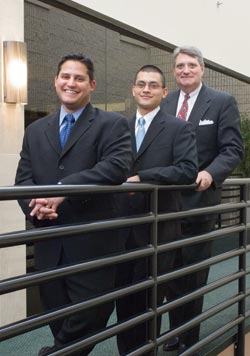Nonprofit D&O: A growth market RLI looks to expand its book of D&O and EPL for nonprofits By Elisabeth Boone, CPCU
In a kinder, gentler time, no one even thought of suing a nonprofit entity, whether it was a small community hospital or an internationally known charity. The people who ran such organizations were assumed to be ethical, well-intentioned, and devoted to the good of humanity rather than to the crass pursuit of power and money. Today, most nonprofits are indeed managed by people who have good motives and high standards. In our lawsuit-happy society, however, a noble character is no defense against allegations of wrongdoing, whether it be sexual harassment, misappropriation of funds, or any of a number of lesser sins. What’s more, nonprofits are no exception to the rule that there are a few bad apples in every barrel, and stories of malfeasance are all too common. Most nonprofits now operate like businesses, with experienced executives, outside directors, and clearly drawn lines of authority and accountability. Moreover, like their brethren in the corporate world, nonprofits face an array of exposures in the area of directors and officers liability. For help in managing these exposures, many nonprofits turn to RLI Insurance Company of Peoria, Illinois, which has been a niche market underwriter since it was established in 1965. Rated A+ by Best’s, RLI has a strong track record in D&O; it has been writing the line without interruption since 1980, and it has posted an underwriting profit in 24 of the last 28 years. RLI writes directors and officers liability and miscellaneous professional liability insurance for both nonprofit and for-profit entities through the Executive Products Group (EPG). Based in RLI’s New York area office in Summit, New Jersey, EPG operates nationwide under the direction of A.Q. (Skip) Orza, vice president. Orza joined RLI in 1998 after 21 years with Chubb, where his last position was managing the directors and officers liability book worldwide, including not-for-profit business. “Our group arranges coverages for all kinds of insureds,” Orza says. EPG’s insureds range from Fortune 500 companies to sole proprietorships, he notes. The group’s target market includes small, mid-sized, and select large-cap publicly traded companies; private companies; and nonprofit health care and other nonprofit organizations. EPG is not a market for higher-risk entities like nursing homes and child care centers. “Directors and officers and miscellaneous professional liability products represent approximately 90% of our gross written premium,” Orza explains. In addition to D&O and MPL, EPG writes coverage for employment practices liability, employee theft, kidnap/ransom, and extortion exposures. EPG also insures fiduciaries of pension and welfare plans against third-party claims and provides coverages for private primary and secondary educational institutions. “Our underwriters have decades of experience,” Orza says. “We give them a lot of autonomy and authority. They are compensated based on the profit they generate, and they’re held personally accountable for their results.
Changing market “The nonprofit D&O policy forms have changed over time,” Orza continues. “Starting about 1980, the industry went from an all-inclusive form to a very narrow D&O type of form, and then the form expanded again to become more inclusive.” Pointing to another market trend, Orza says, “Back in the ’80s, employment practices liability was not a big exposure for not-for-profits. Today, EPL is probably the most significant exposure they face. In fact, about 95% of claim frequency and severity is employment related.” Currently, about 90% of RLI’s D&O business is for-profit entities and the remaining 10% is nonprofits. Orza says his EPG unit is working to expand its writings in the nonprofit sector. “We didn’t realize the true potential in this market until last year, when an aggregator came to us with a $15 million program,” he says. “We looked at it, and it piqued our interest. We discovered that there are dozens of programs like this around the country. The volatility in nonprofit D&O is very low, and we believe that if we apply underwriting discipline to this line, we can make money.” How do the D&O exposures of not-for-profit entities differ from those of for-profit enterprises? Perhaps surprisingly, the answer is: not much. “Nonprofits,” Orza declares, “cannot escape today’s litigious environment simply by virtue of their tax-exempt status.” In fact, their tax-exempt status may actually be the cause of a lawsuit. Orza says: “They’re continually being challenged with respect to their nonprofit status. We’ve seen this recently in the health care industry, where many nonprofit hospitals are being sued, particularly the larger ones.” In some cases, Orza says, the amount of charity care that hospitals are providing and their aggressive collection practices have called into question the hospitals’ nonprofit status. “The practices of these hospitals would lead some people to believe that they were not nonprofit institutions,” Orza says. “Most of the lawsuits against them have been dismissed, and so far there hasn’t been a significant loss,” he observes. But that could change, he cautions. “You think you’re writing an EPL exposure on a nice not-for-profit health care account, and then you find out you have a lot more exposures than that.” At one of the nation’s most prestigious clinics, Orza says, senior management got involved in for-profit entities, as founders or shareholders. “There are some questions about the conflicts of interest that may be inherent in those kinds of relationships,” he says. “Exposures like these aren’t necessarily anticipated, and that makes them difficult to underwrite.” Protecting assets On both the for-profit and not-for-profit sides, “our objective is to protect personal and corporate assets,” Orza says. “We can write coverage on either a primary or excess basis, and we can provide coverage worldwide.” To meet the needs of the nonprofit market, Orza explains, “We took the best features of our directors and officers and employment liability forms for the for-profit market and incorporated them into policies for nonprofits. Then we added coverages that would be needed for this class of business.” Other features of RLI’s Nonprofit Organization and Executive Liability Coverage are automatic outside not-for-profit board coverage; broad punitive damage and spousal liability coverage; automatic merger and acquisition and automatic runoff coverages; debtor in possession coverage; and a broad definition of insured that includes volunteers. Coverage includes penalties assessed under HIPAA; also covered are wrongful employment acts such as wrongful termination, discrimination, harassment, and retaliation. Bilateral discovery and a three-year discovery quote are guaranteed. There is no retention for non-indemnifiable claims brought against individual insureds. Investigations are included in the definition of claim, and coverage is noncancellable except for nonpayment of premium. Both nonprofit forms, Orza says, have duty-to-defend features. “There is no mandatory binding arbitration,” he notes. “‘Loss’ includes both pre- and post-judgment interest, back pay, and front pay.” As for pricing, Orza says, “It’s based on two factors: the employee exposure and the entity’s experience in that area, and the net revenues or total assets that the entity manages. A key criterion is what portion of donations is truly being used for the intended purposes, as opposed to administrative services.” Working with agents RLI’s Executive Products Group distributes its products through both retail and wholesale agents and brokers, Orza says, and EPG is able to accommodate the generalist retailer who may have only an occasional need for the group’s products. Overall, he says, EPG’s business is about 80% retail and 20% wholesale. In some segments of the nonprofit market, Orza says, the large brokers have a strong foothold. “With nonprofit hospitals especially, the larger regionals and the national brokerage houses have achieved significant penetration. These firms usually have divisions or placement offices that specialize in health care risks.” In addition to depth of underwriting expertise, Orza says, EPG offers fast processing of applications. “We pride ourselves on being quick on our feet,” Orza declares. “If you give us a completed application and underwriting submission, we promise you a turnaround in 24 hours. We issue policies within 48 hours of receipt of all outstanding subjectivities if we’re primary. If we’re excess, we just have to have the underlying binders.” Market trends We asked Orza to characterize conditions in the market for nonprofit D&O and EPL coverages. “Capacity has certainly not been a problem for these entities because, surprisingly, outside of the big hospitals, it’s unusual to get a quote for more than $10 million,” he says. “Some of the larger hospital groups may have up to $100 million in coverage, but capacity has never been a real issue.” One exception, he observes, was “the knee-jerk reaction that occurred in the mid-1980s when the D&O market shut down because of problems with publicly traded companies. All boats went down with the tide. I think not-for-profits were hurt because they were portrayed as being as bad as the public companies, and for the most part, they weren’t,” Orza says. A major departure from the norm, he points out, was the scandal involving William Arimony, who was president of the United Way for 22 years until 1995, when he was convicted in federal court of misusing the charity’s money. That scandal, Orza says, underlines the need for scrupulous underwriting of nonprofit D&O and EPL. “We need to know who’s running the operation, how long they’ve done it, what their reputation is, and what the board membership looks like,” he explains. Looking for growth “We really want to grow in this area,” Orza declares, “and we want to do it in the most efficient fashion. Even including the largest hospital chains, the average premium in this line of business is probably $25,000; that’s relatively small. We want to write the smaller institutions, because we think we can be successful in penetrating that segment. We’re building an electronic underwriting box and distributing it to aggregators of this kind of business,” he says. “It’s a bind, quote, and issuance system that will be available 24/7.” Challenges abound in the highly specialized market for nonprofit D&O and EPL. Orza is confident that RLI’s Executive Products Group has the tools to write these risks profitably and to increase its penetration of this growing market. * For more information: |
||||
|




